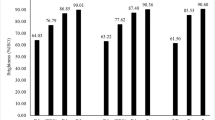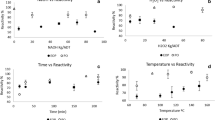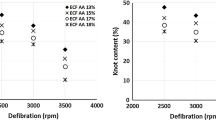Yellowing occurs in grinding for almost all kinds of pulp, but the causes can be due to different mechanisms. One cause is an increase in transparency and a decrease in the specific light scattering coefficient due to this, which increases the intensity of the transmitted light beam and correspondingly decreases the intensity of the reflected light beam and the reflection factor. The second cause is disintegration during grinding of dark, poorly delignified particles (wood residues, shavings, fibril aggregates) not completely removed during sorting. Although some TCF pulp yellows much more strongly during grinding than ECF pulp, it is still early to draw any conclusions concerning the best characteristics in grinding ECF pulp. Much depends on the bleaching reagents, and the type of alkali base used is especially important, which is characteristic of TCF pulps. Pulps bleached with caustic soda yellows less on grinding than pulp bleached with magnesium hydroxide. In the last case, a high residual lignin content was also observed. For the same kappa number, pulps treated with ozone yellow more on grinding than pulps after oxygen-alkali delignification. The kappa number cannot be a good indicator of the degree of delignification in treatment with ozone, since this process cannot remove lignin-containing wood residues and shavings. The behavior of pulp in grinding in this case better characterizes the effectiveness of bleaching.
Similar content being viewed by others
References
F. P. Metzler and R. Rautenbach, Paper, 48, No. 9, 578-583 (1994).
A.-M. Strunz, J. Blechschmidt, and H. L. Baumgarten, Papier, 50, No. 6, 310-319 (1996).
T. M. Runge, A. J. Ragauskas, and T. J. McDonough, TAPPI Puling Conference (1998), pp. 1541-1549.
S. Rudatin, Y. L. Sen, and D. L. Woerner, Association of Kraft Lignin in Aqueous Solutions. lignin Properties and Materials, W. Glasser and S. Sarkanen (eds.), ACS Symposium Series (1989), pp. 145-154.
S. Dutta, T. Garver, and S. Sarkanen, Ibid., 155-176.
B. Dilner and P. Tibbling, in: International Pulp Bleaching Conference Proceedings, 2, SPCI, Stockholm (1991), pp. 59-74.
T. Laxen, H. Ryynänen, and J. Peltonen, Ibid., 19-31.
C.-A. Lindholm, Ibid., pp. 1-17.
H.-U. Süβ and K. Schmidt, Papier, 52, No. 6, 331-333 (1998).
E. Bergnor, M. Ström, and P. Mellander, in: International Pulp Bleaching Conference Proceedings, Vol. 1, TAPPI (1996), pp. 63-70.
R. C. Francis and J. Devenyns, Ibid., pp. 619-622.
Author information
Authors and Affiliations
Additional information
Translated from Khimicheskie Volokna, No. 5, pp. 25-30, September-October, 2009.
Rights and permissions
About this article
Cite this article
Serkov, A.A., Radishevskii, M.B. Effect of bleaching without chlorine on the change in the optical properties of pulp in grinding. Fibre Chem 41, 307–313 (2009). https://doi.org/10.1007/s10692-010-9194-y
Published:
Issue Date:
DOI: https://doi.org/10.1007/s10692-010-9194-y




